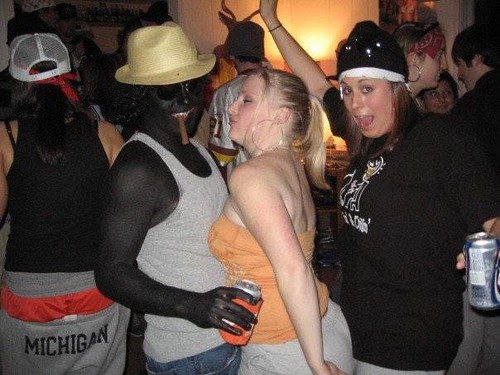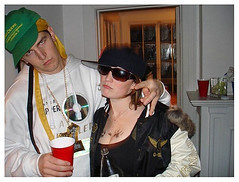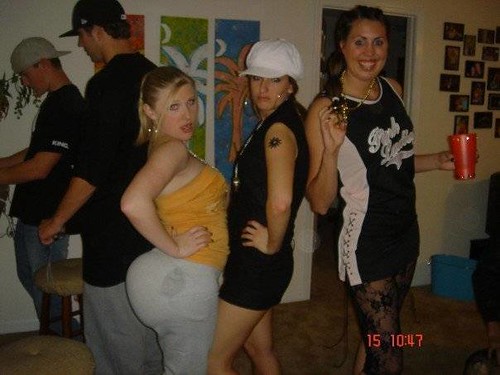The Associated Press
By JESSE WASHINGTON
Cross burnings. Schoolchildren chanting "Assassinate Obama." Black figures hung from nooses. Racial epithets scrawled on homes and cars.
Incidents around the country referring to President-elect Barack Obama are dampening the postelection glow of racial progress and harmony, highlighting the stubborn racism that remains in America.
From California to Maine, police have documented a range of alleged crimes, from vandalism and vague threats to at least one physical attack. Insults and taunts have been delivered by adults, college students and second-graders.
There have been "hundreds" of incidents since the election, many more than usual, said Mark Potok, director of the Intelligence Project at the Southern Poverty Law Center, which monitors hate crimes.
One was in Snellville, Ga., where Denene Millner said a boy on the school bus told her 9-year-old daughter the day after the election: "I hope Obama gets assassinated." That night, someone trashed her sister-in-law's front lawn, mangled the Obama lawn signs, and left two pizza boxes filled with human feces outside the front door, Millner said.
She described her emotions as a combination of anger and fear.
"I can't say that every white person in Snellville is evil and anti-Obama and willing to desecrate my property because one or two idiots did it," said Millner, who is black. "But it definitely makes you look a little different at the people who you live with, and makes you wonder what they're capable of and what they're really thinking."
Potok, who is white, said he believes there is "a large subset of white people in this country who feel that they are losing everything they know, that the country their forefathers built has somehow been stolen from them."
Grant Griffin, a 46-year-old white Georgia native, expressed similar sentiments: "I believe our nation is ruined and has been for several decades and the election of Obama is merely the culmination of the change.
"If you had real change it would involve all the members of (Obama's) church being deported," he said.
Change in whatever form does not come easy, and a black president is "the most profound change in the field of race this country has experienced since the Civil War," said William Ferris, senior associate director of the Center for the Study of the American South at the University of North Carolina. "It's shaking the foundations on which the country has existed for centuries."
"Someone once said racism is like cancer," Ferris said. "It's never totally wiped out, it's in remission."
If so, America's remission lasted until the morning of Nov. 5.
The day after the vote hailed as a sign of a nation changed, black high school student Barbara Tyler of Marietta, Ga., said she heard hateful Obama comments from white students, and that teachers cut off discussion about Obama's victory.
Tyler spoke at a press conference by the Georgia chapter of the NAACP calling for a town hall meeting to address complaints from across the state about hostility and resentment. Another student, from a Covington middle school, said he was suspended for wearing an Obama shirt to school Nov. 5 after the principal told students not to wear political paraphernalia.
The student's mother, Eshe Riviears, said the principal told her: "Whether you like it or not, we're in the South, and there are a lot of people who are not happy with this decision."
Other incidents include:
_Four North Carolina State University students admitted writing anti-Obama comments in a tunnel designated for free speech expression, including one that said: "Let's shoot that (N-word) in the head." Obama has received more threats than any other president-elect, authorities say.
_At Standish, Maine, a sign inside the Oak Hill General Store read: "Osama Obama Shotgun Pool." Customers could sign up to bet $1 on a date when Obama would be killed. "Stabbing, shooting, roadside bombs, they all count," the sign said. At the bottom of the marker board was written "Let's hope someone wins."
_Racist graffiti was found in places including New York's Long Island, where two dozen cars were spray-painted; Kilgore, Texas, where the local high school and skate park were defaced; and the Los Angeles area, where swastikas, racial slurs and "Go Back To Africa" were spray painted on sidewalks, houses and cars.
_Second- and third-grade students on a school bus in Rexburg, Idaho, chanted "assassinate Obama," a district official said.
_University of Alabama professor Marsha L. Houston said a poster of the Obama family was ripped off her office door. A replacement poster was defaced with a death threat and a racial slur. "It seems the election brought the racist rats out of the woodwork," Houston said.
_Black figures were hanged by nooses from trees on Mount Desert Island, Maine, the Bangor Daily News reported. The president of Baylor University in Waco, Texas said a rope found hanging from a campus tree was apparently an abandoned swing and not a noose.
_Crosses were burned in yards of Obama supporters in Hardwick, N.J., and Apolacan Township, Pa.
_A black teenager in New York City said he was attacked with a bat on election night by four white men who shouted 'Obama.'
_In the Pittsburgh suburb of Forest Hills, a black man said he found a note with a racial slur on his car windshield, saying "now that you voted for Obama, just watch out for your house."
Emotions are often raw after a hard-fought political campaign, but now those on the losing side have an easy target for their anger.
"The principle is very simple," said BJ Gallagher, a sociologist and co-author of the diversity book "A Peacock in the Land of Penguins." "If I can't hurt the person I'm angry at, then I'll vent my anger on a substitute, i.e., someone of the same race."
"We saw the same thing happen after the 9-11 attacks, as a wave of anti-Muslim violence swept the country. We saw it happen after the Rodney King verdict, when Los Angeles blacks erupted in rage at the injustice perpetrated by 'the white man.'"
"It's as stupid and ineffectual as kicking your dog when you've had a bad day at the office," Gallagher said. "But it happens a lot."
Associated Press writers Errin Haines, Jerry Harkavy, Jay Reeves, Johnny Taylor and researcher Rhonda Shafner contributed to this report.
Hosted by Google
Copyright © 2008 The Associated Press. All rights reserved.




